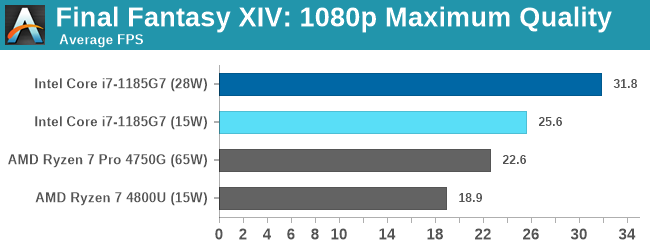Intel’s Tiger Lake 11th Gen Core i7-1185G7 Review and Deep Dive: Baskin’ for the Exotic
by Dr. Ian Cutress & Andrei Frumusanu on September 17, 2020 9:35 AM EST- Posted in
- CPUs
- Intel
- 10nm
- Tiger Lake
- Xe-LP
- Willow Cove
- SuperFin
- 11th Gen
- i7-1185G7
- Tiger King
Xe-LP GPU Performance: Final Fantasy XIV
Despite being one number less than Final Fantasy 15, because FF14 is a massively-multiplayer online title, there are always yearly update packages which give the opportunity for graphical updates too. In 2019, FFXIV launched its Shadowbringers expansion, and an official standalone benchmark was released at the same time for users to understand what level of performance they could expect. Much like the FF15 benchmark we’ve been using for a while, this test is a long 7-minute scene of simulated gameplay within the title. There are a number of interesting graphical features, and it certainly looks more like a 2019 title than a 2010 release, which is when FF14 first came out.
With this being a standalone benchmark, we do not have to worry about updates, and the idea for these sort of tests for end-users is to keep the code base consistent.


This is an easy win for Intel.











253 Comments
View All Comments
tipoo - Friday, September 18, 2020 - link
Sounds like their next Macbook releases are going to be Apple Silicon, not sure we'll ever see a TGL Apple system.AMDSuperFan - Thursday, September 17, 2020 - link
What worries me the most is that this Tiger is better than Renoir in every way possible. I feel like Intel is the Apple of laptops now and our AMD are some knockoff tablet with good specs but not up to snuff. This 4 core beating the 8 core Renoir is terrible. I know we have Big Navi coming and that should save us here, but right now the Nvidia and Intel products are really bad for us fans.Spunjji - Friday, September 18, 2020 - link
I worry about the mental health of the person running this account.eddman - Thursday, September 17, 2020 - link
Why intel didn't do 6-8 core low power models again? 10nm too power hungry? Low yields and/or low manufacturing capacity?Spunjji - Thursday, September 17, 2020 - link
Yes!But seriously, all of the above.
eek2121 - Thursday, September 17, 2020 - link
Fab capacity.RedOnlyFan - Friday, September 18, 2020 - link
Hahaha. Fake informationSpunjji - Friday, September 18, 2020 - link
What's your explanation then, Red? "They didn't want to"?They compete well with AMD at 15W but need 28W to get full performance from the design. Squeezing twice as many cores in would push them way, way off the bottom of their efficiency curve. They're running more complex cores than AMD and they require more power, no way around that.
If yields were good enough they'd have had 8-core Ice Lake designs out taking the fight back to AMD on the desktop, but mysteriously they skipped those and rehashed Skylake again. It's almost like something was holding them back...
JayNor - Thursday, September 17, 2020 - link
Intel chose to integrate high performance wifi6, thunderbolt 4, avx512, dlboost, pcie4 features rather than the more small hammers approach.Alder Lake will have even smaller and lower power cores than AMD's, so perhaps next year the choice for Cinebench processing will get funny.
RSAUser - Thursday, September 17, 2020 - link
You mentioned this again, so I'll comment again:WiFi 6/802.11ax: AMD does not do networking equipment, it's also not part of the CPU, it's an
extra module attached to the mobo.
PCIe 4: No benefit in laptops, there's no SSD that can really max it out consumer side and GPU wise. PCIe 4 consumes a lot more power than 3rd gen.
Thunderbolt 4: You actually mean USB 4.
AVX512: Not many things actually use this, a majority of those use-cases can just go GPU, and you're not really running an AVX512 workload on a laptop.
DLBoost: Intel's ML library, you're not training ML libraries on a laptop CPU, you'd near always want to use a GPU instead, plus that specific one is Intel's trademark one, you'd use open source alternatives.
AMDs' leaked roadmaps are USB 4 and PCIe 4 in 2022, and here you didn't mention LPDDR5, which is also included in that release.